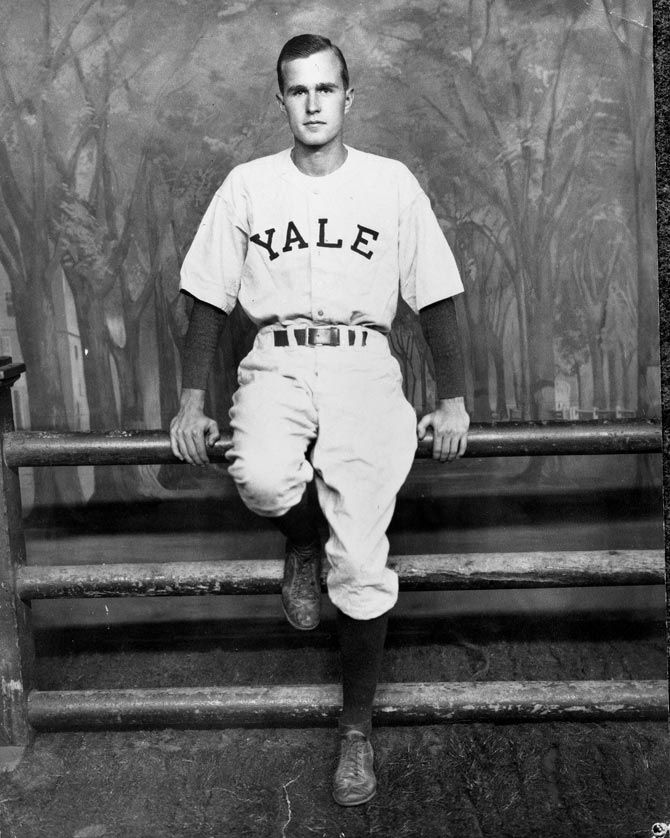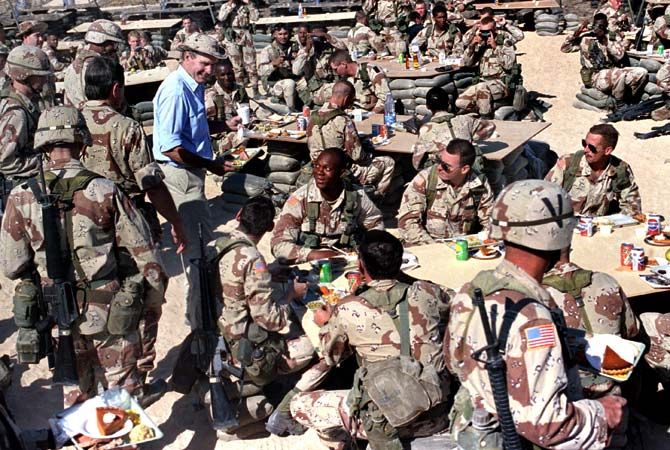With a rich political and personal legacy, former United States President George Herbert Walker Bush left no shortage of memorable images from his time in and out of office.
'Pappy' Bush passed into the ages on Friday, age 94, just eight months after his wife Barbara died.
The 41st US president, US congressman, Central Intelligence Agency director, US envoy to China and oil businessman was only the second man after John Adams to have a son as president -- '43', George W Bush.
The son remembered his father as 'a man of the highest character and the best dad a son or daughter could ask for.'

His love for the sport never diminished and after he became president in 1989, he kept a prized possession in his Oval Office desk drawer: The first baseman's mitt he wore playing for the Yale varsity team more than 40 years earlier. Photograph: George Bush Presidential Library and Museum/Reuters

Bush served as one of the youngest naval aviators in World War II.
He flew TBM Avenger torpedo bombers from the carrier USS San Jacinto in 1944.
For his 58 combat missions, Lieutenant Junior Grade Bush was awarded the Distinguished Flying Cross and three Air Medals. Photograph: George Bush Presidential Library and Museum/Reuters

This is George Sr with Barbara and his eldest child George in Rye, New York in 1955. Photograph: Reuters

In 1966, Bush was elected to a seat in the United States House of Representatives from the 7th District of Texas.
In 1976, then US President Gerald Ford appointed Bush as director of the Central Intelligence Agency. He served as CIA boss for 357 days, from January 30, 1976 to January 20, 1977. Many credit Bush for restoring the agency's prestige. Photograph: George Bush Presidential Library and Museum/Reuters



Bush succeeded Ronald W Reagan. He entered office at a period of change in the world; the fall of the Berlin Wall came early in his presidency, the collapse of the Soviet Union came in 1991.
In his Inaugural Address, Bush said: 'I come before you and assume the presidency at a moment rich with promise. We live in a peaceful, prosperous time, but we can make it better.'
'For a new breeze is blowing, and a world refreshed by freedom seems reborn; for in man's heart, if not in fact, the day of the dictator is over.'
'The totalitarian era is passing, its old ideas blown away like leaves from an ancient, lifeless tree.'
'A new breeze is blowing, and a nation refreshed by freedom stands ready to push on.'
'There is new ground to be broken, and new action to be taken.' Photograph: George Bush Presidential Library and Museum/Reuters

His visit came a little before Operation Desert Shield and Operation Desert Storm.
On August 2, 1990, Iraqi dictator Saddam Hussein had invaded oil-rich neighbour Kuwait. Bush responded by assembling an international coalition of nearly three dozen nations.
Under the leadership of General Norman Schwarzkopf, a five-month air bombardment dubbed Operation Desert Shield and the subsequent 100-hour Operation Desert Storm land battle pushed Iraqi troops out of Kuwait.
But it stopped short of ousting Saddam, setting up the second Gulf War that was initiated in March 2003 by George W Bush. Photograph: Rick Wilking/Reuters


This was when he Strategic Arms Reduction Treaty was signed by Bush and Gorbachev in Moscow. The treaty took nine years in the making.
The contentions in START would reduce the strategic nuclear weapons of the United States and the USSR by about 35 per cent over seven years, and the Soviet Union's land-based intercontinental ballistic missiles would be cut by 50 per cent.
Bush described START as 'a significant step forward in dispelling half a century of mistrust'.
After the dissolution of the USSR in 1991, Bush and Gorbachev declared a US-Russian strategic partnership, marking the end of the Cold War. Photograph: Rick Wilking/Reuters

By a margin of 43 percent to 37 percent, Clinton, aformer governor of Arkansas with little experience in foreign affairs, ended the presidency of the man who prevailed over Panama's dictator Manuel Noriega, Saddam and the Soviet empire.
Despite his disappointment, Bush was ever gracious in defeat.
In a handwritten note to Clinton dated January 20, 1993, Bush wrote: 'I'm not a very good one to give advice; but just don't let the critics discourage you or push you off course. ... Your success is now our country's success. I am rooting for you.' Photograph: Gary Hershorn/Reuters

Life came full circle for the Bush family after W was elected to the US presidency, the first father-son to become Presidents after John Adams and John Quincy Adams. Photograph: Eric Draper/White House Photo/Reuters


The Medal of Freedom is the highest civilian honour in the United States.
'America has lost a patriot and humble servant in George Herbert Walker Bush,' Obama noted.
'While our hearts are heavy today, they are also filled with gratitude. Our thoughts are with the entire Bush family tonight and all who were inspired by George and Barbara's example.' Photograph: Larry Downing/Reuters









